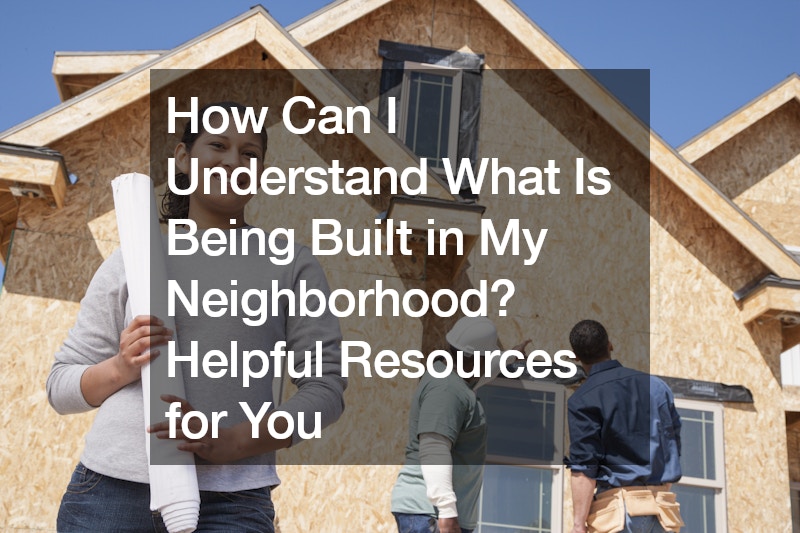
1. What Is Being Built in My Neighborhood?

When wondering what is being built in your neighborhood, there are several ways to find out. One option is to visit the local planning department and request information on new construction projects. Additionally, websites and apps such as Zillow or Redfin can provide updates on new developments in the area. Community meetings and forums are also valuable resources for learning about upcoming projects.
Developers and contractors may also have information on new construction projects and be open to direct communication with residents. Pay attention to any signs or notices posted in the neighborhood about upcoming developments. Public records can also offer insights into new construction plans and approvals.
To stay updated on construction progress, consider subscribing to newsletters or notifications from the local government or developers. By utilizing these resources, you can be well-informed about what is being built in your neighborhood.
2. How Can I Determine the Impact of New Construction on My Neighborhood?
Understanding the impact of new construction on your neighborhood is essential. One primary concern for residents is how new developments will affect property values. Increased construction can also lead to changes in traffic patterns and parking availability in the area. Additionally, consider the aesthetic impact of new buildings and how they will blend with the existing neighborhood. If you see crane rental systems around, or a team of experienced and dedicated commercial concrete professionals, you could start to draw some conclusions. Working with professional commercial concrete companies is common for large-scale repair or installation projects.
Environmental concerns should also be taken into account when assessing the impact of new construction. Will the new buildings bring more businesses and services to the area, or will they disrupt the community’s existing dynamics? By considering these factors, you can better gauge the long-term effects of new construction on your neighborhood.
To voice your concerns or opinions about new developments, attend public meetings or hearings and participate in the review process. It may also be beneficial to access studies or reports on the impact of new construction in similar neighborhoods. By being proactive and informed, you can contribute to shaping the future of your community.
3. How Can I Get Involved in the Planning and Approval Process?

When wondering what is being built in your neighborhood, there are several ways to find out. One option is to visit the local planning department and request information on new construction projects. Additionally, websites and apps such as Zillow or Redfin can provide updates on new developments in the area. Community meetings and forums are also valuable resources for learning about upcoming projects.
Residents have several avenues to get involved in the planning and approval process for new construction projects. Attending planning meetings or hearings allows you to voice your feedback directly to decision-makers. Providing suggestions or feedback on new projects can also influence their development.
Community organizations focused on development issues provide a platform for residents to collaborate and advocate for their interests. You can also participate in the review process for new projects, submit petitions or letters to local officials, and engage with advisory boards related to development. By actively participating in the process, you can play a role in shaping the future of your neighborhood.
Local government officials play a crucial role in the planning and approval process for new construction. Stay informed about changes to zoning laws and regulations that impact development in your neighborhood. Take advantage of public comment periods to express your views and ensure that your concerns are heard and addressed.
4. How Can I Protect the Character of My Neighborhood?
Preserving the character of your neighborhood amidst new construction projects is a common concern for residents. Advocating for historic buildings or landmarks helps maintain the area’s unique identity. Design guidelines and architectural standards can also ensure that new developments align with the neighborhood’s aesthetic.
Residents can prevent overdevelopment by understanding building height and density restrictions in the area. Supporting local businesses and fostering community identity are ways to preserve the neighborhood’s character. By participating in the design review process and proposing alternative plans for developments, you can play an active role in protecting the essence of your community.
Resources such as public records, community organizations, and public comment opportunities can assist residents in voicing concerns about changes to the neighborhood. By leveraging these resources and advocating for responsible development practices, you can help safeguard the character of your neighborhood.
5. How Can I Stay Informed About Future Development Plans?

To stay informed about future development plans in your neighborhood, seek out comprehensive plans or visions for development in the area. Websites, newsletters, and publications covering development news can provide updates on upcoming projects and initiatives. Subscribing to alerts or notifications ensures you receive timely information about new construction projects.
Attend public meetings and events where future development is discussed, and engage with local government officials to learn about proposed changes or additions to the neighborhood. By staying proactive and accessing available resources, you can stay informed about upcoming development projects and participate in shaping the future of your community.
Residents can also advocate for specific types of development, influence development priorities, and propose alternative uses for properties in the neighborhood. By collaborating with local stakeholders and supporting inclusive, diverse, and sustainable development practices, you can help guide the direction of development in your community.
6. How Can I Influence the Direction of Development in My Neighborhood?
Residents have the power to influence the direction of development in their neighborhood. By providing input on development priorities and suggesting alternative uses for properties, you can shape the future of the community. Supporting affordable housing and mixed-use developments fosters a diverse and inclusive neighborhood.
Residents can collaborate with local stakeholders, participate in workshops on neighborhood planning, and advocate for sustainable development practices. By promoting community engagement and responsible development, you can influence the design and layout of new developments in your neighborhood.
When wondering what is being built in your neighborhood, there are several ways to find out. One option is to visit the local planning department and request information on new construction projects. Additionally, websites and apps such as Zillow or Redfin can provide updates on new developments in the area. Community meetings and forums are also valuable resources for learning about upcoming projects.
Advocating for green spaces, public amenities, and best practices in development also contributes to positive growth in the community. By showcasing successful examples of positive development and collaborating with developers for mutually beneficial projects, residents can support positive development practices in their neighborhood.
7. How Can I Access Information on Building Permits and Regulations?
Accessing information on building permits and regulations is crucial for understanding new construction projects in your neighborhood. Check with the local authorities or online databases to find information on building permits for new developments. Know the rules and regulations governing construction activities in your area.
Verify that developers and contractors have the necessary permits for their projects to ensure compliance with zoning laws. Reporting violations or illegal construction activities helps maintain the integrity of the neighborhood. Familiarize yourself with building codes, inspection processes, and public records related to construction in your area.
Understanding the inspection process, building requirements, and potential violations empowers residents to stay informed and address concerns about construction activities. By learning about building permits and regulations, you can navigate the development landscape in your neighborhood more effectively. Speaking with local vinyl window companies, as well as concrete contracting companies and metal supply teams, can boost your understanding, too.
8. How Can I Support Positive Development in My Neighborhood?
Supporting positive development in your neighborhood involves community involvement and collaboration with developers. Residents can contribute to shaping the future of the community by engaging in development decisions and promoting inclusive and diverse projects. Partnering with local businesses and advocating for green spaces enhances the quality of new developments.
Residents can showcase successful examples of positive development in the neighborhood and collaborate with design professionals on new projects. By aligning with best practices and advocating for responsible development, residents can help create a vibrant and sustainable community for all. Stay informed about development initiatives and resources available for supporting positive growth in your neighborhood.
By advocating for green spaces, public amenities, and best practices in development, residents can help shape the future of their neighborhood. Supporting inclusive and diverse projects, collaborating with developers, and showcasing successful development examples contribute to positive growth in the community.
9. How Can I Address Concerns About Noise, Dust, and Disruption from Construction?
When wondering what is being built in your neighborhood, there are several ways to find out. One option is to visit the local planning department and request information on new construction projects. Additionally, websites and apps such as Zillow or Redfin can provide updates on new developments in the area. Community meetings and forums are also valuable resources for learning about upcoming projects.
Construction activities can sometimes cause noise, dust, and disruption in the neighborhood. Residents can familiarize themselves with guidelines for construction noise and hours of operation to know what is permissible. Reporting excessive noise or disturbances from construction sites helps maintain a peaceful environment for residents. Some other services you may be unfamiliar with could include basement repair, the nuances of hydro excavation, and an experienced drywall company, all of which use dumpster rental agreements to get rid of their waste.
Regulations are in place to minimize dust and debris from construction activities, and developers can take steps to mitigate disruptions to the community. Staying informed about upcoming construction projects and addressing concerns or complaints directly with developers can help alleviate issues related to noise, dust, and disruption in the neighborhood.
Residents can also learn about construction safety practices, request information on the environmental impact of construction projects, and take steps to ensure their safety and well-being during construction. By being proactive and communicative, residents can address concerns about noise, dust, and disruption from construction activities in their neighborhood.
10. Conclusion
In conclusion, understanding what is being built in your neighborhood is essential for residents to make informed decisions and actively participate in shaping the community’s future. By utilizing the resources and strategies outlined in this article, you can stay informed about new construction projects, assess their impact, and get involved in the planning and approval process.
Construction activities can sometimes cause noise, dust, and disruption in the neighborhood. Residents can familiarize themselves with guidelines for construction noise and hours of operation to know what is permissible. Reporting excessive noise or disturbances from construction sites helps maintain a peaceful environment for residents. Some other services you may be unfamiliar with could include basement repair, the nuances of hydro excavation, and an experienced drywall company, all of which use dumpster rental agreements to get rid of their waste.
When wondering what is being built in your neighborhood, there are several ways to find out. One option is to visit the local planning department and request information on new construction projects. Additionally, websites and apps such as Zillow or Redfin can provide updates on new developments in the area. Community meetings and forums are also valuable resources for learning about upcoming projects.
Residents have the opportunity to protect the character of their neighborhood, influence the direction of development, and support positive growth through community engagement and advocacy. By collaborating with developers, local stakeholders, and design professionals, residents can play a significant role in creating a vibrant, sustainable, and inclusive community.
Addressing concerns about noise, dust, and disruption from construction activities requires proactive communication with developers, local authorities, and fellow residents. By advocating for responsible construction practices, promoting safety measures, and staying informed about upcoming projects, residents can help ensure a harmonious and quality living environment in their neighborhood.



